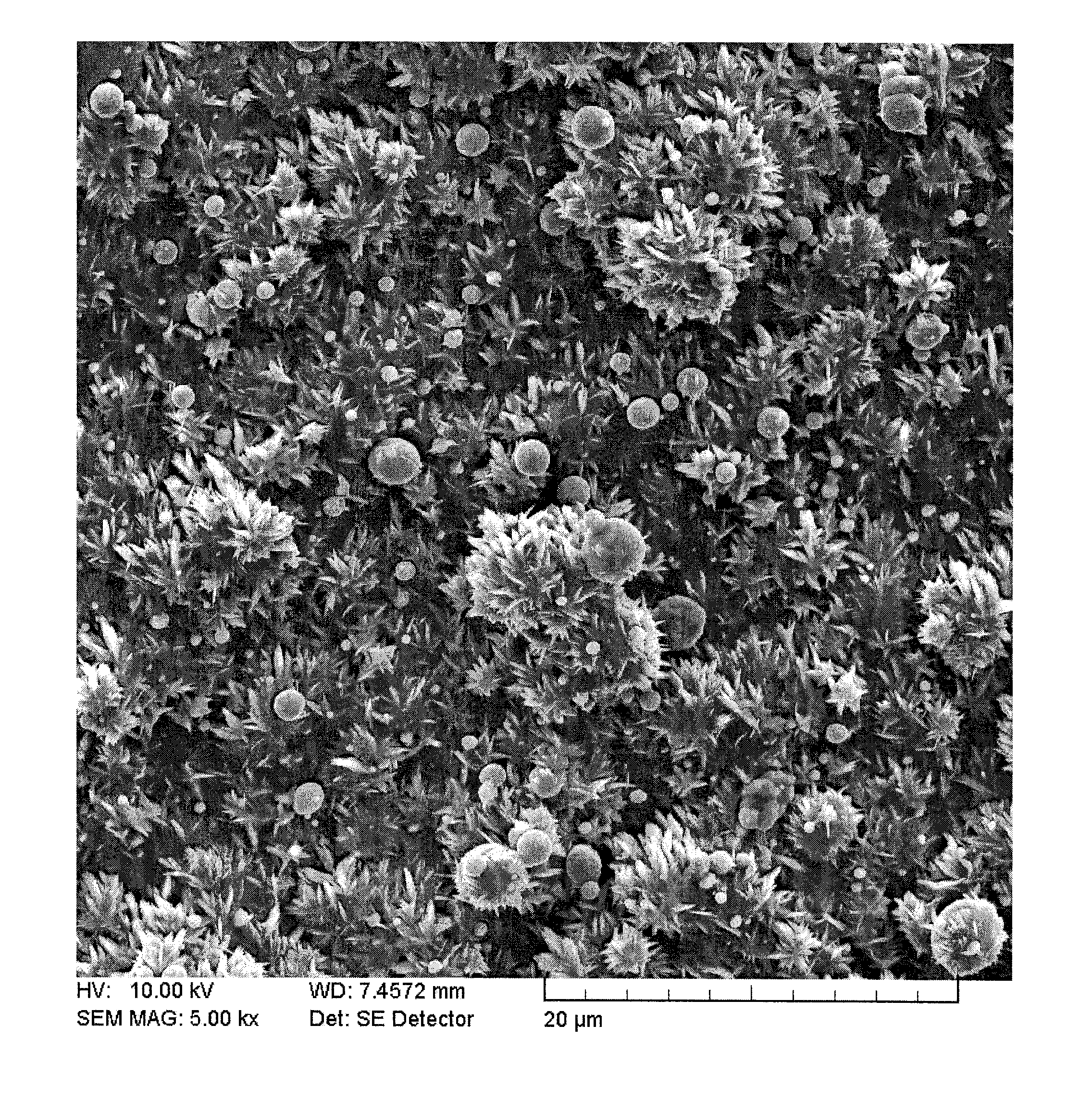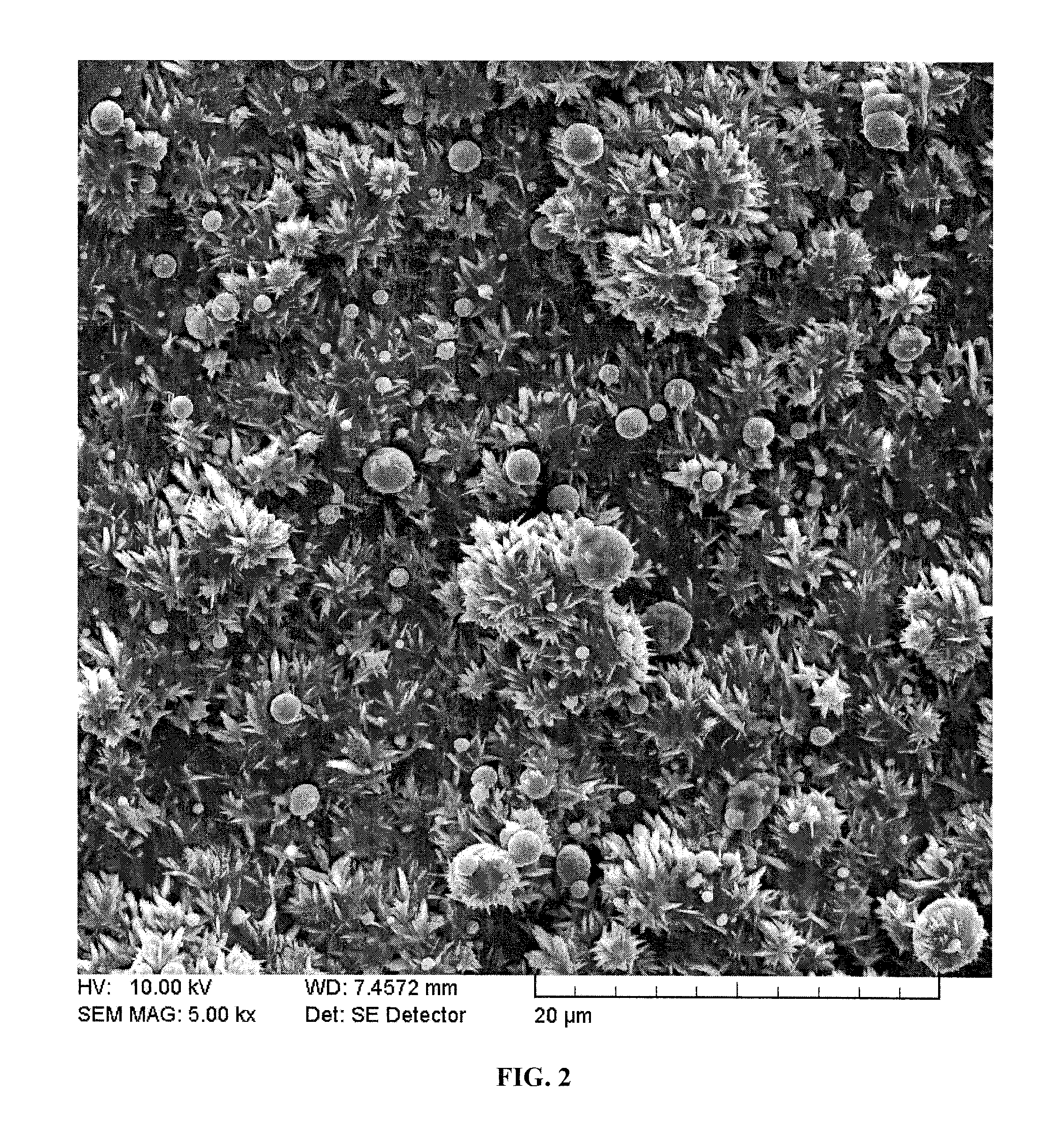Spinulose titanium nanoparticulate surfaces
a technology of spinulose titanium and nanoparticulate surfaces, applied in the field of substrate surfaces, can solve the problems of tin oxide fishbone-like nanostructures, circuit impedance, etc., and achieve the effects of increasing the number and density of ti spinulites, increasing the surface area for attachment, and increasing the coverage of the substrate surfa
- Summary
- Abstract
- Description
- Claims
- Application Information
AI Technical Summary
Benefits of technology
Problems solved by technology
Method used
Image
Examples
example 1
Nanoplasma Deposition of Titanium
[0077]Substrates used were stainless steel, nitinol, CoCrMo alloy, silicon, titanium, glass, silicone, poly(methyl methacrylate) PMMA, polyurethane (PU), polytetrafluoroethylene (PTFE), polyvinyl chloride) (PVC), polyethylene terephthalate (PET), ultra high molecular weight polyethylene (UHMWPE), polyethylene terephthalate glucol (PETG), polyetheretherketone (PEEK) and polypropylene (PP). Samples were prepared with an approximate surface area of 1 cm2. Except for the silicon which was delivered clean, all the other substrate materials were ultrasonically cleaned before deposition in detergent (ChemCrest #275 at 160° F.), rinsed in deionized water and dried in hot air.
[0078]Clean substrates were then placed in the chamber and exposed to nano-plasma deposition (NPD). The cathode was commercially pure titanium cathode (grade 2). The substrates were mounted in the vacuum chamber at distances from 8 to 28 in from the cathode (measured from the centre of t...
example 2
Spinulose Titanium Nanostructured Surfaces
[0090]316L stainless steel substrates (1.6 cm2×0.1 cm, mirror polished (McMaster-Carr, Elmhurst, Ill.) were cleaned in an ultrasonic bath, rinsed with deionized water and dried in air. The substrates were placed in the vacuum chamber on a floating holder approximately 13 in from the cathode surface at an angle of θc=0° with a θs of 0°. Prior to deposition, the chamber was pumped to a base pressure of at least 0.088 mPa.
[0091]The deposition was carried out in 5 minute intervals with 90 min intervals of no arc current and no gas flow. This deposition-pause cycle was repeated 9 times. A 300 A arc discharge was generated in a background of 160 mPa of argon on a pure titanium (grade 2) cathode (20 in×6 in).
[0092]Samples were imaged in a FEG-SEM (Tescan Mira), operated with an accelerating voltage of 10 kV. The images showed a pronounced spinulose morphology (see FIG. 2) with the fraction of surface area covered by spinulose features estimated to ...
example 4
Spinulose Titanium Coated Polymer Substrates
[0097]Titanium was deposited by nanoplasma deposition as in Example 2 on several different substrates. The following materials were used as substrates: PTFE, PET, PETG, PEEK, PMMA, PVC, PU, UHMWPE, PP and silicone.
[0098]PTFE, PET (1 cm2×0.5 cm) substrates (McMaster-Carr), silicone (1.3 cm2×0.3 cm) substrates (McMaster-Carr), PMMA, PVC, PU and UHMWPE (1.2 cm outer diameter×1.3 cm length) cylindrical shaped substrates from McMaster-Carr) were cleaned in an ultrasonic bath, rinsed in deionized water and dried in air. The substrates were placed in the chamber on a floating holder approximately 13 in from the cathode surface at an angle of θc=0° with a θs of 0°. Prior to deposition the chamber was pumped to a base pressure of at least 0.907 mPa.
[0099]The deposition was carried out in 5 minute intervals, with 90 minute pauses in between of no arc current and no gas flow. This deposition-pause cycle was repeated 9 times. A 200 A arc discharge was...
PUM
| Property | Measurement | Unit |
|---|---|---|
| time | aaaaa | aaaaa |
| average spike height | aaaaa | aaaaa |
| width | aaaaa | aaaaa |
Abstract
Description
Claims
Application Information
 Login to View More
Login to View More - R&D
- Intellectual Property
- Life Sciences
- Materials
- Tech Scout
- Unparalleled Data Quality
- Higher Quality Content
- 60% Fewer Hallucinations
Browse by: Latest US Patents, China's latest patents, Technical Efficacy Thesaurus, Application Domain, Technology Topic, Popular Technical Reports.
© 2025 PatSnap. All rights reserved.Legal|Privacy policy|Modern Slavery Act Transparency Statement|Sitemap|About US| Contact US: help@patsnap.com



